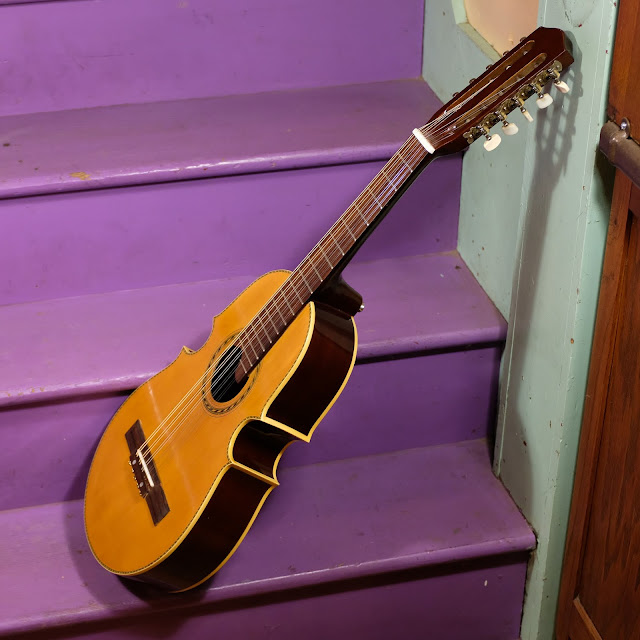2000s Cuatro/10-String Octave Mandolin Conversion
The consignor of this instrument picked-up a banjo from me recently and, due to his "one-in, one-out" policy, this little Puerto Rican cuatro wound-up in the workshop. I departed from its original concept, however, as a jangly octave-strung instrument tuned in fourths and, while getting it ready to go, converted it into a 5-course octave mandolin tuned GDAEB -- the high B string is the "extra." I suppose one could retune this any number of ways, though, or use an open or modal tuning to get that "modern cittern" effect going.
It's an unmarked, plywood-body instrument but it came in decent shape. I'd imagine it was probably a $300-400 instrument when new as it's a little fancier and better-put-together than the average el-cheapo versions one finds on eBay for ~$150 or so and has some great-looking purfling.
Work included: a fret level/dress, sanding of the bridge, relocation of the saddle slot for better intonation/compensation (why do makers always put them 1/8" too forward on these?), a replacement side dot at the 5th fret (it was missing), new bone, drop-in saddle, and a good setup. It plays spot-on with hair-above 1/16" G and 1/16" DAEB action at the 12th fret and the neck is straight. Gauges are 42w/42w, 30w/30w, 18w/18w, 13/13, 8/8. They could be bumped-up one gauge on the plains and a couple on the wounds and still keep the instrument happy.
Scale length: 20 7/8"
Nut width: 1 15/16"
String spacing at nut: 1 9/16"
String spacing at saddle: 2 1/2"
Nut width: 1 15/16"
String spacing at nut: 1 9/16"
String spacing at saddle: 2 1/2"
Body length: 17 3/8"
Lower bout width: 11 1/4"
Upper bout width: 8 1/2"
Lower bout width: 11 1/4"
Upper bout width: 8 1/2"
Side depth at endpin: 3"
Top wood: ply spruce
Back/sides wood: ply maple(?)
Neck wood: mahogany family
Fretboard: rosewood
Back/sides wood: ply maple(?)
Neck wood: mahogany family
Fretboard: rosewood
Neck shape: flat board, medium C/D rear shape
Bridge: rosewood
Nut: original plastic
Saddle: new bone
Condition notes: it has minor wear throughout, but is actually pretty clean. I'm not sure if this was actually made in the 2000s, but it's possible it's been around since the '90s. The rear of the bridge has a 2mm (depth) gap at its back-edge where it meets the body. I'm not concerned because paper sliding into it only goes that 2mm and it has two factory-installed bolts hidden under the two dots on its "deck." Various parts of the tuners have been replaced -- a button here, a shaft there -- over time.


















Comments